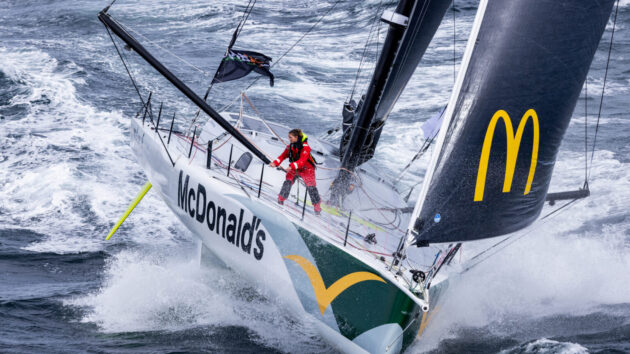It’s not just enough to set out on an adventurous voyage – you need to capture it as well. But has ‘social media’ sailing gone too far?
Our defences have run out: social media has well and truly infiltrated our precious, antiquated sailing world. It’s terrifying to think that our secret passage to escapism and isolation at sea has been discovered. But, like most things that scare us, could there be a thrilling aspect to this challenge?
Decades ago, sailors could go ‘dark’ and justifiably claim the atmospheric conditions weren’t great and the SSB radio wasn’t working. Now, if we don’t live stream every part of daily life at sea, our followers feel disappointed.
As this past Vendée Globe has demonstrated, raw, unedited, and ‘real’ daily updates are now considered the norm. It’s expected – by sponsors, race organisers and content-craving supporters. And so, life at sea for any sailing professional has changed. Now we have to adapt to not one, but two higher powers: Mother Nature, and her fierce deputy: The Algorithm.
Depression in the face of a storm is never useful for a sailor. The shift has happened, and there is no going back. So we need to adjust our course and harness its power.
One upside to wide stream internet at sea is that, when used effectively, it provides a platform for lesser-known sailors to gain recognition and ‘win’ in a broader sense. Violette Dorange is a fantastic example of this. She now has 650,000 followers on Instagram and 3.1 million likes on TikTok, having come 23rd in her first Vendée Globe.
To put Violette’s online prowess into perspective, race winner Charlie Dalin has 73,000 followers on Instagram.
Starting the Vendée at all is considered the pinnacle of many a solo-sailing career. But to get noticed among a fleet of 40 incredible competitors is another feat, and one she mastered with aplomb.
Article continues below…
Online sailing communities and apps: Speaking to Sailing La Vagabonde stars
Fleeting acquaintance has always been part of sailing, particularly for bluewater cruisers. A friendship struck up over a rum cocktail…
10 women doing great things in competitive sailing right now
With a Women’s America’s Cup due to start in 2024, a gender balanced sailing event at the Paris Olympic Games,…
That impact will be a huge bonus for Violette as her career develops. There’s no doubt she will go on to achieve great things in sailing, and her social media mastery will be part of that story.
Another positive thing about social media and an increased online presence for sailing is how it casts the net wider. Participation in major sailing events around the world is decreasing and it’s a major problem. We need to attract more people back to – or new people into – the sport.
US ocean racer Cole Brauer has nearly half a million followers on Instagram, including many of those harder-to-reach audiences: women, younger people. Most of her followers were non-sailors – she told Yachting World that many followers didn’t even know she was competing in a solo race.
Maybe you think that’s silly. I think it’s brilliant. Sailing at the top of ‘normal’ people’s newsfeeds normalises the sport and will inevitably tempt more people onto the water.
But while I do have some enthusiasm for social media, I believe we need to heed caution. There is a shadowier side to the cyber influence at sea.

Professional racers are now expected to document ever moment of their race. Photo: Pip Hare Ocean Racing / Medallia
Practically, it’s really hard work. Memories of endless ‘liquid detected in charging port’ alerts, trying to work a smartphone screen with wet fingers, and having to look at myself speaking into a camera after four days at sea with minimal sleep still haunt me.
But now that demand for social media output has spiked, will it negatively impact sailing performances? Is it actually possible to sail with the exceptional superiority and focus of racers like Charlie Dalin or Yoann Richomme, and put out the quantity of social media required?
People have always followed sailing for the drama and the adventure. It’s what made Ellen MacArthur, Pete Goss and Peter Blake such household names – they had an epic story to tell. But, they told their stories with hindsight. Now we are demanding a real-time connection to the action and to the personal journey of the sailors. Will that push them to make seamanlike choices?
I could easily imagine a scenario where a skipper might feel pressured to wake up the off-watch in an ocean race for a sail change, not because they need to, but because it could make for better drama. We’re already pushing humans to the edge with the increasing speed of ocean racing boats – is a social media output quota a step too far? Guidelines are going to be needed, and soon.
Ultimately sailors are optimists and adaptable. But before we resign our fate to algorithms, we need to work out how to integrate this – possibly wonderful – tool into our sport in a healthy way.
 If you enjoyed this….
If you enjoyed this….
Yachting World is the world’s leading magazine for bluewater cruisers and offshore sailors. Every month we have inspirational adventures and practical features to help you realise your sailing dreams.Build your knowledge with a subscription delivered to your door. See our latest offers and save at least 30% off the cover price.






